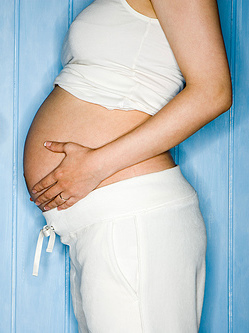So after reading the article, if you have questions or care to share a story, please call (712- 432-0900) the show so we can talk in person. We would love to hear from you! On the show, I am going to expose something I did not know about myself until I spoke with Dr. Michael Fox, http://www.google.com/search?rlz=1C1LENN_enUS469US469&sourceid=chrome&ie=UTF-8&q=dr+fox+low+carb+diet, on the Low Carb Cruise.
If you are pregnant, thinking about it or practicing, you’ll want to tune in to Jimmy Moore’s “Ask The Low-Carb Experts” (Episode 16) entitled “Pregnancy & Kids”, Thursday June 7th.
A Page From My Pregnancy Journal that was tweaked a little by Atkins
I’m pregnant? I’m pregnant! A million and one questions are racing through my head as my joy competes with twinges of concern. There’s one thing I’m sure of: that I’ll be able to provide my babies—I’m having twins—with the best environment in which to grow.
I’m a registered dietitian and certified diabetes educator, so nutrition is what I do best. I understand the importance of eating adequate amounts of a variety of nutrient-rich foods—and there is nothing more important to a growing fetus than good nutrition. I have been following a controlled carbohydrate lifestyle for several years and will continue to do so throughout my pregnancy.
During pregnancy I’m following the guidelines of the Lifetime Maintenance phase of the Atkins Nutritional Approach™, which is the most liberal in carbohydrate intake. (The weight-loss phases of Atkins are not appropriate for pregnant or lactating women.) This phase will not only ensure normal growth for my babies and help prevent potential complications, such as neural-tube defects and gestational diabetes. It will also keep me healthy.
As you can see from my typical daily menu, listed below, I am eating lots of food with lots of variety, so I’m getting plenty of nutrients. My usual intake ranges between 100 and 150 grams of protein, 50 to 90 grams of carbs and approximately 1,800 to 2,000 calories. Interestingly, I have none of the cravings for specific foods that often plague pregnant women nor am I battling constipation. I am not turned off by certain foods, another common side effect of pregnancy. After my first trimester my energy level was fine, meaning that I had no need to nap in the middle of the day. I attribute all these positive effects to my diet. For more information on having a healthy pregnancy, see Vitanutrients for Pregnancy and Foods to Avoid in Pregnancy.
Breakfast
1/2 avocado
Smoked salmon rolled around a teaspoon of cream cheese
Sliced tomato and onion
Midmorning snack
2 meatballs on Atkins bread
Lunch
Large salad made of greens, tomato, cucumber, artichoke, asparagus, mushrooms, broccoli, red cabbage, walnuts and onion, dressed with olive or flaxseed oil and vinegar
Chicken breast cutlet
Midafternoon snack
Berries with cottage cheese
Dinner
Steak
Sautéed spinach and red peppers in garlic and oil
Steamed asparagus
Peach
Snack Time Even with years of nutrition education under my rapidly expanding belt, when I was feeling tired and nauseous in the early months I sometimes found it hard to eat the right foods. That’s why it is important to have a few light, high-protein foods handy at all times. My favorites are:
|
“On October 23, supervisor of education and research for Atkins Health & Medical Information Services Valerie Berkowitz gave birth to twins. Gabrielle and Aiden weighed in at 5 and 6 pounds, respectively. Congratulations to Valerie and her husband, Keith. While she was expecting, Val was more careful than ever about her eating habits.”







